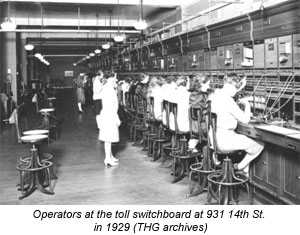Telecommunications History Group Resources
931 14th St. Historic Building
Odd Floors Through Ten; Eleven, Twelve, Thirteen - Building Tour
 Floors three, seven, and nine were home to various business and administrative offices. The third floor housed the Accounting Department. The seventh floor contained a part of the Engineering Department, including employees whose job it was to make blueprints, photostats and photographs for the company. The commercial department was located on the ninth floor; they were not a group who prepared TV commercials (TV wasn’t around yet), but instead took care of the various commercial (as in commerce-related) activities of the company, such as rates and charges, sale of stock, studies, reports, and more.
Floors three, seven, and nine were home to various business and administrative offices. The third floor housed the Accounting Department. The seventh floor contained a part of the Engineering Department, including employees whose job it was to make blueprints, photostats and photographs for the company. The commercial department was located on the ninth floor; they were not a group who prepared TV commercials (TV wasn’t around yet), but instead took care of the various commercial (as in commerce-related) activities of the company, such as rates and charges, sale of stock, studies, reports, and more.
Operators staffed switchboards on the fifth floor. Why did the phone company need operators if the step switches provided automatic service? The new switches couldn’t handle every situation; for instance, all long distance calls had to be placed through an operator. Also, all toll calls had to go through an operator, and the operators were there to help those customers who dialed wrong numbers or to provide information.
Sidebar: Women Operators
In September 1878, Emma M. Nutt became the first female telephone operator, in the Telephone Dispatch Company exchange at Boston, Massachusetts. Emma was paid $3 per day, and continued to work as an operator for 33 years. (The company took its responsibilities seriously and had very maternal rules, hence the name “Ma Bell.”) Being an operator was one of the few respectable jobs for women at the time. A young woman could get a job as a servant, a factory laborer, sales clerk, nurse, or teacher. Many jumped at the chance to be an operator and by 1900, almost all operators were women. By the 1890s, women were also employed as office staff such as typists and secretaries. Women were telegraph operators, too. (See the THG Operators page for more.)
They were also able to relax in the operators’ lounge. This room had wide windows with a view of the mountains, and it was lavishly furnished and otherwise appointed. Colorful imported glazed chintz draperies accented the windows, a fireplace in one corner was surrounded by gray, gold, green, and rose tiles, and the “many luxurious chairs, sofas, chaise lounges, beautiful coffee tables, occasional tables adorned with gorgeous lamps, and distinctive screens which form a background for special groups of furniture are not excelled in many of the richest and most fashionable homes.” Small wonder that many of the operators who had to work a split shift were reportedly “so delighted with their new quarters” that they stayed at work between shifts.
The fifth floor also contained a first aid room, lavatories, and private dressing rooms with showers or tubs for the operators’ use.
The eleventh, twelfth, and thirteenth floors were home to the General Accounting Department (eleventh floor), the Publicity and Treasury Departments (twelfth), and the Legal Department (thirteenth). The twelfth floor also contained the offices of the Assistant Vice President.
